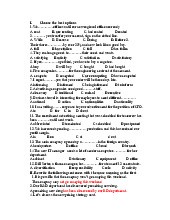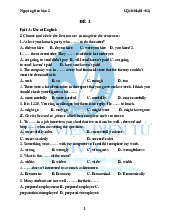



Preview text:
lOMoAR cPSD| 49431889 THE FOREIGN EXCHANGE MARKET PREVIEW a> Discussion 1.
How many different currencies can you name? 2.
How is the value (the exchange rate) of your currency determined? 3.
Has the exchange rate, compared to the US dollar or the euro, remained
constant over the last few years? 4.
Do you know the history of your currency over the past 50 years? a> Exchange rates
Look at the timeline below, showing key dates in the development of exchange rate
systems around the world. Match the dates with the events (a – e) below. 1944 1971 1973 1992 2002 a.
Most industrialized countries switched to a system of floating rates.
However,governments and central banks occasionally attempted to influence
exchange rates by intervening in the markets. So there was a system of managed floating exchange rates. b.
The Bank of England lost over £5 billion in one day attempting to protect
thevalue of the pound sterling. After this, governments and central banks intervened
much less, so there was almost a freely floating system. c.
A fixed exchange rate system was started. The values of many major
currencieswere pegged (or fixed) to the value of the US dollar. The American central
bank, the Federal Reserve, guaranteed that it could exchange an ounce of gold for $35. d.
Twelve states of the European Union introduced a single currency, the euro,
toreplace their national currencies. e.
Gold convertibility ended because the Federal Reserve no longer had
enoughgold to back the dollar, due to inflation. lOMoAR cPSD| 49431889 READING
The foreign exchange market is the market in which such national currencies as
dollars, pesos, deutschemarks, yen, francs, and others are exchanged. It is not an
organized market with fixed hours and a physical meeting place, such as the New
York Stock Exchange or Chicago Board of Trade. The foreign exchange market is
an over – the – counter market, the primary communication instruments being the
telephone and the computer. The market has developed rapidly in the past quarter
century, and the volume of activity has escalated dramatically in response to the
growth in the volume of world trade in goods and services, and especially in
response to the expansion of international capital flows – the acquisition of financial
and real assets across national borders. Total worldwide foreign exchange market
transactions in 1996 were approximately $1.2 trillion, or $1,200 billion per day.
More than 90 percent of these transactions are associated with capital flows. Among
the most important financial centers are New York, London, Tokyo, Paris, Frankfurt,
Hong Kong, and Zurich. Among them, London is the world’s largest foreign
exchange centre. Banks here trade almost $200 billion each day in foreign currencies.
London’s trading position arises partly from the large volume of international
financial business generated here – insurance, Eurobonds, shipping, commodities
and banking. London also benefits from its geographical location which enables it
to trade not only with Europe through-out the day but also with the US and the Far
East, whereas time difference makes it difficult for those two centres to trade with
each other. When banks in London begin trading at 8 a.m. they can deal with banks
in Tokyo, Hong Kong, Singapore whose trading day is just ending. From 1 p.m.
London banks can trade with banks in New York: before they close at 5 p.m., their
counterparts may be in Los Angeles or San Francisco. The foreign exchange market thus trades 24 hours a day.
The foreign exchange market enables banks and international corporations to trade
foreign currencies in large amounts. Capital flows arising from trade in goods and
services, international investment and loans together create this demand for foreign currency.
Foreign exchange trading is divided into spot and forward business. Generally
speaking, spot transactions are undertaken for an actual exchange of currencies
(delivery or settlement) two business days later (the value date). lOMoAR cPSD| 49431889
Forward transactions involve a delivery date further into the future, possibly as far
as a year or more ahead. By buying or selling in the forward market a bank can, on
its own behalf or that of a customer, protect the value of anticipated flows of foreign
currency from exchange rate volatility.
Broadly speaking, there are three types of participants in the market: customers, such
as multinational corporations, are in the market because they require foreign
currency in the course of their cross border trade or investment business. Some banks
participates as market makers; that is their dealers will at any time quote buying and
selling rates for currencies – dollars to the pound, deutschemarks to the dollar and
so on. Other banks or corporations call them ask for their rates, and then buy or sell
as the caller chooses. The dealers earn a profit on the difference between their buying
and selling rates, but clearly they have to be ready to change their prices very quickly
so that they avoid holding large volumes of a depreciating currency, or being short
of a rising currency. The third type of participant, the brokers, acts as intermediaries
between the banks. They are specialist companies with the telephone lines to the
banks throughout the world so that at any time they should know which bank has the
highest bid (buying) rate for a currency and which the lowest offer (selling) rate. By
calling a broker, therefore, it should be possible for banks to find the best dealing
rate currently available. The broker doesn’t deal on his own account but charges a commission for his services. COMPREHENSION 1.
What is the foreign exchange market? 2.
Why is it considered to be an OTC market? 3.
Why is London the world’s largest foreign exchange centre? 4.
What are two types of transactions in the foreign exchange market? 5.
How many types of participants are there? Who are they? 6.
For what purposes do multinational corporations need foreign currencies? 7.
What do the terms “bid rates” and “offer rates” mean? 8.
How do brokers participate in the foreign exchange market? VOCABULARY EXERCISES 1.
Match up the half-sentences below. lOMoAR cPSD| 49431889
1 To ‘peg’ a currency against something means to
2 A clean floating exchange rate
3 Exchange controls used to limit
4 Speculators buy or sell currencies in order to 5 ‘Market forces’ means
6 ‘Hedging’ meansA the amount of a country’s money that residents were able
tochange into foreign currencies.
B fix its value in relation to it.
C make a profit by making capital gains or by investing at higher interest ratesD is
determined by supply and demand. E
trying to insure against unfavorable price movements by way of futurescontracts. F
the determination of price by supply and demand (the quantity available and thequantity bought and sold).




